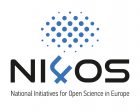Now we turn our attention to researchers and their work in the view of EOSC. We are setting up an interview series for channeling the experiences of local community members of EOSC and the changing culture of scholarly communication. Our first interviewee is Evangelia Chrysina, Senior Researcher in the Institute of Chemical Biology at the National Hellenic Research Foundation.
What are the challenges in your research work and how can FAIR & ORDM help you addressing them?

My research work focuses on structural biology with emphasis on biomedical and biotechnological applications using mainly X-ray protein crystallographic and during the last years structural bioinformatics. Knowledge of the three-dimensional structure of proteins is essential to understand their function and there is a number of methods employed for this purpose. X-ray protein crystallography has been one of the most popular ones, followed by NMR, SAXS and electron microscopy.
Structural biology is a multidisciplinary research field that nurtures data openness during the last decades. This year, the Protein Data Bank (PDB) [1-2], a database of all known 3D protein structures, celebrates its 50ieth anniversary since its establishment [3]; during all these years, the data deposited with PDB have been open, findable and accessible by the scientific community and significant efforts have been made to ensure that these data are interoperable and reproducible. The challenges that structural biologists face nowadays, lie in the data load that they are expected to handle. The methods used for the 3D structure determination produce a tremendous amount of data and meta data that both facilities and users struggle to handle efficiently.
The greatest challenge for structural biologists, though, is structure interpretation.
Evangelia Chrysina
For example, when I started visiting Synchrotron Radiation Sources, back in 1995, data collection of a complete set of diffraction images from a protein crystal exposed to X-rays, required about eight hours, while now within only a few minutes at least 20 times more data are collected. The greatest challenge for structural biologists, though, is structure interpretation. Most of these proteins are therapeutic targets and are exploited for the design and development of new therapeutic agents using the structure-based drug design approach. Any additional data available from diverse sources are of utmost importance to reach the most plausible conclusions on their mechanism of action. Therefore, both data FAIR-ness and Open Research Data Management Plans are absolutely essential to allow structural biologists shed light on the structure-function relationships of the protein molecules converting the existing information to knowledge.
The Covid-19 pandemic is an excellent paradigm that underlines how data interoperability fosters the development of a number of research initiatives that reinforced the achievements of the scientific community utilizing the groundwork that structural biologists have laid.
How has your research benefitted from EOSC?
My research has indirectly benefitted from EOSC and more specifically from EOSC-Life; Instruct-ERIC is the pan-European research infrastructure on Structural Biology [4]. Instruct members have already been successful in the calls announced by EOSC-Life to support data, tools workflows in the life sciences fostering interdisciplinary collaborations by building open digital collaborative space for biological and medical research [5-6].
The results of these studies are most valuable for my research objectives, and I anticipate that when Greece joins Instruct-ERIC as full member my group along with the Greek structural biologists across the country will have the opportunity to be directly involved in such initiatives, providing, making use of in vitro, in vivo or in silico data and/or metadata or contributing to the development of standard tools and services.
How can EOSC benefit from your work?
The EOSC may benefit from individual researchers if an open dialogue is initiated. This may involve probing diverse scientific communities including structural biologists, with the aim first to portray and then to propose flexible, tailor-made workflows and data management practices that will be integrated in the researchers’ daily routine. This process will allow open data sharing, data harmonization and development of user profiles that will be feasible and easily adopted.
National and European Research Infrastructures may foster such a mapping exercise increasing the quality and integrity of structural biology data by preparing catalogue of services and standard APIs. We have taken the first steps to this process through the distributed national RIs on structural biology coordinated by NHRF in cooperation with our partner “Athena RC”.

Links and resources
[1] https://www.rcsb.org/
[2] https://www.ebi.ac.uk/pdbe/
[3] https://www.rcsb.org/pages/pdb50, https://www.asbmb.org/meetings-events/pdb50
[4] https://instruct-eric.org
[5] https://instruct-eric.org/news/instruct-and-the-cloud-eosc-life-open-call-series/
[6] https://www.eosc-life.eu/services/demonstrators/
